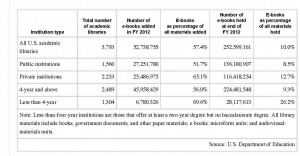The history of the codex includes myriad and often convoluted ways of producing and distributing the book to readers. Current day production and distribution of eBooks is no different in its dizzying variety. To narrow things down, here I will present a snippet of the information available on how eBooks get to readers within the higher education system. In particular, I want to mention some ways in which university libraries acquire and distribute eBooks.
First of all, universities and colleges are increasing acquiring more eBooks than print books; among all U.S. academic libraries, as of 2012, more than half of their added materials were eBooks. This is especially true for community colleges, which makes sense given it would be more convenient for their commuter student population to access materials remotely. But, for all libraries, eBooks make sense; physical books take up a lot of space, which translates into the need for more real estate. A perpetual problem for libraries continues to be the need for space for their collections.
See the table below from the Chronicle of Higher Education, “Almanac of Higher Education, 2014,” extracted from U.S. Department of Education figures, FY 2012 (http://chronicle.com.ezproxy.gsu.edu/article/Percentage-of-E-Books-at/147835/).
Table of Percentage of E-Books at Academic Libraries, by Institution Type, FY 2012
University or college libraries depend on a variety of means to provide eBooks to users and there are several different kinds of middle-people distributors who provide content to be consumed by readers via different methods. First, and perhaps most simply, eBooks can be purchased from an individual publisher or a book distributor—and most likely these are the publishers and distributors who also sell them print texts. Names such as Baker and Taylor and Ingram will be familiar to readers who have worked at bookstores and have ordered books from these distributors, which also serve libraries. But eBooks come to libraries from other sources by subscription. Some of these subscriptions provide a library user access to e-books, but the library doesn’t technically own the book; other subscription services provide access to the eBook, but after a certain number of check-outs, the library then automatically buys the eBook. Academic libraries, according to articles I’ve read, are constantly trying to figure out the most economical way to provide their users with the greatest range of options for the best price, and it’s not an easy landscape to navigate.
For more information, see the article: Walters, William H. “E-Books in Academic Libraries: Challenges for Acquisition and Collection Management.” Libraries and the Academy 13:2 (2013): 187-211.
A subscription service, in my experience, can require several steps beyond just a click on a hyperlink in the library catalogue. Some services I’ve used at the GSU library to obtain eBooks include books24x7 and ebrary—and both require a separate user name and log-in on top of the log-in to the library system itself, which is slightly irritating, but very manageable. Ebrary also requires a download of the software Adobe Digital Editions, which, though free, required a level of computer operating system that I did not have. As a result, I needed to use a computer on campus to read the eBook. Of course, I was very happy to have access to a book that was incredibly expensive and not available anywhere else, and when I do upgrade my laptop, I’ll be able to read it from home. And, by using an eBook, I eliminated the extra step of having to return the book physically by a certain date to the library.
Happy digital reading, Amanda

